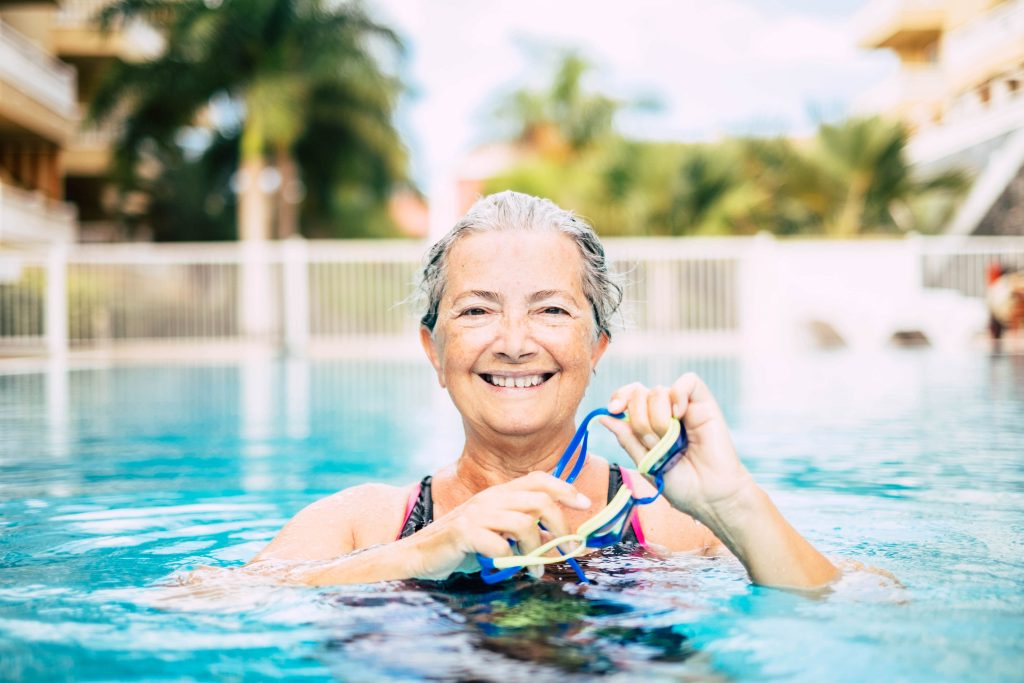
How can one even think of retirement communities in Florida without visualizing a lifestyle surrounded by water? Beautiful beaches. The sound of waves approaching the shore. Opportunities for aquatic sports and excursions on the water. The availability of so many high-end water amenities in gulf-side communities like The Glenview at Pelican Bay.
There are definitely perks to living in Pelican Bay – beaches, nature preserves, Pelican Bay golf resorts, beachfront dining, and shopping in Naples. But one perk that does not automatically come to mind is the senior lifestyle benefits of abundant water amenities that could positively impact your personal health and wellness.
Here, we’ll tell you how to use water to help you meet your fitness goals. We’ll explain why swimming and water aerobics are so good for you and will even provide you with a few easy and safe water exercises that could enhance your quality of life as a senior.
Is Swimming Good Exercise?
As your reliable resource for all things senior living-related in the Naples area, we at The Glenview found valuable information through research that explains why exercise—while partially or fully submerged in water—offers such an advantage. According to the AgingCare Newsletter, exercising in water offers:
- Improved Balance. Water provides natural resistance and support, decreasing your risk of falls and fall-related injuries.
- Increased Strength. Water helps build endurance and muscle strength in your core and extremities without the need for special equipment while giving you increased confidence during exercise.
- Minimal Impact. Arthritis pain often hinders an older person’s ability to exercise on dry land. In the water, there’s significantly less stress on joints, enabling seniors to exercise pain-free for longer periods of time.
Into the Sea.
You don’t have to travel far to reach the gulf in Pelican Bay or Naples. So, let’s first address water aerobics in the gulf as opposed to water exercises in a swimming pool—that’s next!
Pushing through waves is tougher than swimming laps in a pool, so it will work your heart, as well as shoulder and leg muscles, even harder. In addition, the waves make you work harder to stabilize yourself, which is great for the core muscles. Gulf swimming is a REAL workout—building endurance, strength, and cardio fitness. Did you ever wonder why you—or your visiting grandchildren—are so hungry after an active day at the beach swimming in the gulf?
Easy, Safe, and Helpful Swimming Pool Exercises.
Water Aerobics has gotten a bad rap in the past. The term seems to connote a lot of work! So, here we’re sticking to easy, safe, and helpful water exercises. Our research led us to a great online video resource by Todd R. Parry, M.D., an orthopedic surgeon from Revere Health Coral Desert Orthopaedics in St. George, Utah. In his video, Dr. Parry takes you through each exercise—step-by-step—from the comfort of a beautiful swimming pool in a lush tropical setting.
Finding a beautiful setting for water exercise is the first of Dr. Parry’s two prerequisites for an enjoyable water fitness experience. At The Glenview, against a backdrop of the gulf, nature, three miles of pristine beaches, and a beautiful new sundeck, you would enjoy Dr. Parry’s exercises in the community’s new outdoor swimming pool. In addition, as a resident at The Glenview, you’d also enjoy pool amenities at the Pelican Bay Community Center.
“Just get in a pool and MOVE,” Dr. Parry says—his second prerequisite. He goes on to explain that “water is the perfect physical therapy medium because it helps lift and support, and when you get stronger (after inactivity or following accidents, ankle sprains/other injuries, and surgeries, especially knee or hip replacements), the water will provide great resistance.”
Before you get started, invest in a pair of good goggles and a pair of water shoes. The shoes will help protect the bottom of your feet from the plaster on the bottom of the swimming pool. As you get into a regular water exercise routine, you may also want to purchase a pair of webbed water gloves that make your hands extra resistant and able to push more water.
For the Lower Extremities (Follow Dr. Parry’s Video here for good visuals):
- Marching or walking. Start in water that’s waist-high. Power walk. Lift your knees. For a more intense workout, move to more shallow water.
- Advance to running. Again, waist-high water. Running will bring both feet off the ground at the same time and really helps to strengthen legs.
- Then, hop on one leg across the pool and switch legs. This will be easier in the deeper end, so go with your stronger leg in the shallow end/weaker leg in the deeper end.
- Try Jumping. Squat down deep and jump up. This makes you flex your knee and hip.
- Water lunges. This is so hard on land, but much easier in the water. This exercise will slowly build up your quads and stretch your hamstrings. One leg front, one behind, lunge down.
- Push-Offs. Use your legs to push off hard from the side of the pool and swim underwater to the other side. Push-off and swim back.
- Step-ups. Learn to do steps in and out of the pool. If you fall, it’s back into the water. This is especially good if you’ve had a knee replacement and are not able to do steps very well on dry land.
- Kicking. With your back to the pool wall, support yourself with your arms on the ledge and start kicking just near the water’s surface. Transition to a jogging motion as you would do on land to work your knees more.
For the Upper Extremities (Follow Dr. Parry’s Video here for good visuals):
The following are good for shoulder and elbow strengthening. And remember, the harder you push with your hands (positioned like fans) the more the water resists. Dr. Parry suggests alternating within your routine the lower extremity exercises above with these for the upper body:
- Push-back/Push-forward. In shoulder-deep water, raise your arms shoulder-height and position your hands, palms open, like fans perpendicular to the water. Push the water back and forth front to back. (Can also be done from just the elbow instead of the shoulder.)
- Push-down/Push-up. With arms at your sides, now push up and back with fan-hands level with the water. (Do this from just the elbow, as well.)
- Spine Rotation. In chest-high water standing with legs shoulder-width apart, position your hands as fans one on top of the other in front of you. Move side-to-side. This helps with the abs as well as the back/spine.
- Push-ups. On pool steps, position your arms shoulder-width apart, lean in, and push up as hard as you can.
Next Steps . . .
Anytime is a good time to add a new dimension to your health and wellness routine. It just may be swimming or other forms of water exercise—and we know the perfect place. The coastal living opportunities at The Glenview—Florida’s only nonprofit equity-owned LifeCare community—are endless, especially during the winter months. At The Glenview, residents are the primary managers of their community—they have a say in how the community operates. This start of a new year is the perfect time to investigate the privileges of homeownership at The Glenview.
Start with our online virtual Parade of Homes, and then contact us to arrange for a personal onsite tour.


